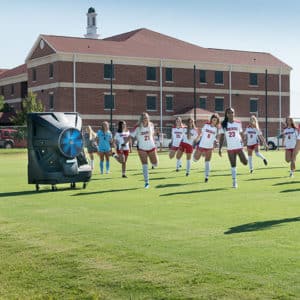
Whether you were born in a state that experiences extreme heat or you’ve recently moved, you likely know that high temperatures can be uncomfortable at best – and deadly at worst. This is particularly true for athletes who may be practicing and playing outdoor sports in the season’s peak temperatures, pushing through games and tournaments in pursuit of victory. It is crucial, then, that coaches and parents know how to protect their athletes throughout every practice and competition as we move into summer.
Proactive Measures
Heat-related illnesses are common among athletes exposed to heat and exercise for long periods of time. They are undoubtedly one of the most dangerous risks to athletes, with heat stroke acting as the leading cause of death in athletes. The body’s heat production is 15-20 times greater during exercise than it is at rest, and it is important to keep an athlete’s overall body temperature from rising too much. However, there are measures to take in order to proactively prevent heat-related illnesses: hydration, weather-smart attire, and regular breaks with access to cooling and shade.
Hydration
Ensure your players stay hydrated with water and sodium-containing sports drinks before, during, and after outdoor exercise. Water or sports drinks can provide the hydration the body needs to produce sweat, thereby lowering its temperature to safer levels.
Weather-Smart Attire
Wearing the proper clothing can significantly improve a player’s performance and reduce their risk of heat-related illnesses. Make sure your athletes wear loose-fitting clothing made from a lightweight open-weave material. And when they play under the sweltering summer sun? Make sure those jerseys are light colors.
Cooling and Shade
Athletes should have access to an indoor building or an outdoor, shaded location when they exercise outside. An indoor building might be nearby at a school or recreation center, but if an indoor building is not available, shade will still provide a safe location for the athlete to recover. Make sure athletes are regularly taking breaks in the shade, and if possible, provide wet cloths to help them cool their bodies externally.
In addition to hydration, proper attire, and shade, additional tools can help prevent heat-related illnesses, such as a portable evaporative cooler. University of North Texas Senior Associate Athletic Director of Sports Jeff Smith understands the toll heat can take on his players. He and his team take multiple measures to help their athletes prevent overheating, including hydration, proper nutrition, and ice tubs during recovery. But they also know how important it is to have the suitable materials to keep athletes cool when they are at their highest risk during practices or games. Smith’s secret weapon? Portacool portable evaporative coolers. Smith relies on these coolers to keep his team cool from warmup through the game or practice. He considers them a critical piece of safety equipment that can help players recover from the effects of heat and proactively prevent the worst side effects from occurring in the first place.

Treatment
Should heat-related illnesses occur – as they can, even when precautions are taken – it is vital to know the signs of these illnesses and take action as soon as possible. According to the CDC, it is crucial to watch for symptoms of more severe heat-related illnesses such as heat exhaustion and heatstroke. Heat exhaustion, in which the athlete experiences heavy sweating, cold and clammy skin, nausea, dizziness, or fainting, is severe but treatable at the scene. Remove the athlete to a cool place and provide water while you put cool cloths on their body. Call 911 right away if the athlete is vomiting or not showing signs of improvement. Heatstroke, by contrast, must be treated by medical professionals immediately. It occurs when body temperature is higher than 103 degrees Fahrenheit, and the individual is experiencing confusion, nausea, and loss of consciousness. In cases of suspected heatstroke, cool the person’s temperature with wet cloths, but do not give them anything to drink. Follow the directions of medical personnel to ensure the best treatment.
As we move into the summer, we must ensure athletes of all ages are prepared not just to win in competition but to stay healthy and hydrated while exercising outside. Talk to your athletes about the risks and symptoms of heat-related illnesses; support their needs with water breaks, cool recovery areas, and proper attire. And most importantly, know how to treat heat-related illness if it does occur. With greater awareness and preparedness, we can better prevent heat-related illnesses and allow our athletes to do what they do best: play ball.
For more information on Portacool evaporative cooler options to help athletes stay cool in the heat, visit our product page.